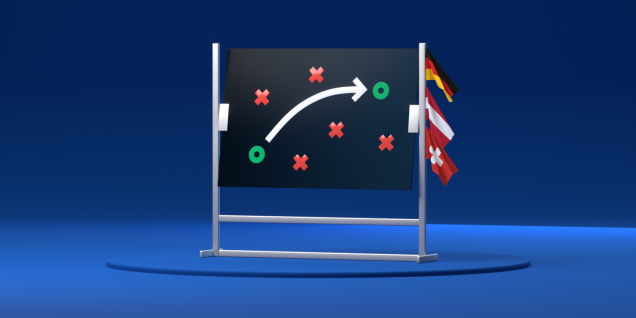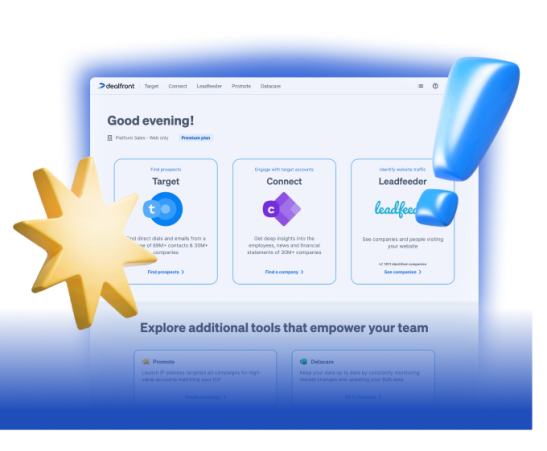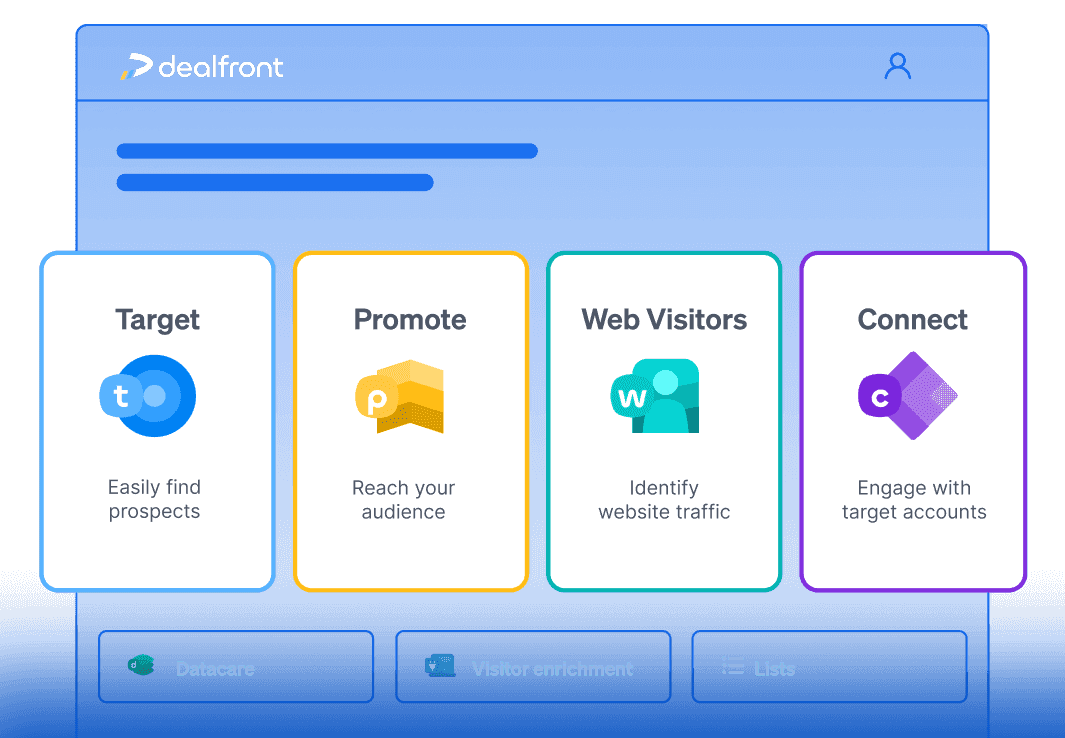Have you already tried to stake your claim in the German-speaking region of Europe? Then you might have noticed that selling works differently there than in other parts of the world.
This region of the European market is highly competitive and lucrative, but having an amazing sales pitch alone isn't going to cut it. Language and culture can prove to be huge barriers if you haven't done your research. So what really matters to your customers and prospects in the German-speaking market?
Win in DACH with a solid B2B sales strategy
We’ll take a look behind the scenes of B2B in DACH to find out how this market ticks. Whether you've already entered the region or looking to jump in, we'll give you insights on:
how Germans, Austrians, and the Swiss prefer to do business.
setting up strategies to win and keep customers.
the skills and tools you’ll need.
GDPR and e-Privacy-compliant sales.
Understanding the DACH market
What does DACH stand for?
D = Deutschland (Germany)
A = Austria
CH = Switzerland (from the Latin: Confoederatio Helvetica)
Where Germany and Austria are part of the EU (European Union), Switzerland is not. This will become relevant when we talk about GDPR and e-Privacy regulations.
Economic overview
Germany's economy, which represents 4.54% of the global market, boasts a strong small and medium enterprise (SME) sector. It is also one of the most important players in the European economic market, alongside the United Kingdom and France.
Although Austria and Switzerland aren't necessarily on the same economic playing field, their economies aren't anything to be sneezed at. Austria is at the 23rd spot on the list of the wealthiest countries in terms of income per capita, and Switzerland is known for its banking and luxury goods sectors.
Cultural differences
Just because the region speaks the same language, don’t make the mistake of lumping these countries together culturally. However, there are common cultural threads that weave through the DACH region:
Punctuality (not just in a business setting) is essential, and being late, even five minutes, is considered rude.
You should be tactful and show empathy.
People want detailed insights about your product and expect you to be specific in your approach.
Politeness and not being familiar are appreciated.
Business practices
Business in the DACH region tends to lean more towards the formal side. That means a suit and tie in the more traditional industries and more casual with startups. How you address people in the context of business is also important. The formal “Sie” is preferred in almost all cases. However, once you’ve established trust, perhaps your counterpart will offer that you use the less formal “Du” in your dealings.
Although how you speak with people can be industry dependent, we advise you to go the formal route first to avoid any awkward situations. In Austria, for example, using someone’s title is also recommended. So if they’re a Doctor or Professor, please address them as such.
Also important in all DACH countries:
You’re expected to have a structured approach in your business dealings.
Back up what you have to say with facts and figures.
What about language? Can you get away with not speaking German? Even if many people speak English in an organization, doing business in English will be difficult. English knowledge is highly dependent on the location, industry, and education level. Very often, in more traditional industries in smaller cities, you are less likely to find that English is accepted as the business language. Also, doing business with the DACH region in German will help build rapport and trust much faster.
Key components of a successful B2B sales strategy in DACH
Understanding how the DACH region ticks is one important aspect, but this knowledge will be useless if you don’t have a solid B2B sales strategy in place.
Defining your ideal customer profile
Great! You have a product or service that you know organizations need. But just who is that ideal customer for your business? Setting up an ideal customer profile (ICP) is at the core of all your sales (and marketing) efforts.
Not to be confused with a buyer persona, the ICP defines the ideal customer at the company level. The tighter your ICP definition is, the more likely you’ll have shorter sales cycles and higher customer retention rates. What information do you need to define your ICP?
Company size
Industry
Annual revenue
Number of clients
Their target market
Company tech stack
Website visitors per month
Sales channels
This is certainly not an exhaustive list, but it’s a great place to start.
Important: You will need multiple ICP definitions if you offer different tiers for your product or service.
Creating a strong value proposition
Your product or service may look good on the surface, but what’s truly in it for your prospects and customers? It’s about discovering what they want and need. What can they achieve with your product or service that they couldn’t before?
You’ll want to ask yourself the following:
Financial: Will your product/service improve your customer’s bottom line or help them save costs?
Remove the barriers: Will your product/service make the day-to-day processes more efficient and productive?
Gains: Will your product/service help grow their business?
Target your value proposition for the right prospect, ideally the decision-maker. What someone in marketing needs is different than what an Operations Manager needs. Then, figure out what their pains are and how you can solve them.
You also need to understand your competition. Go to review websites like G2 and see what your target customers are saying about the competition. Can you take advantage of a weak spot with your offering?
Once you have a handle on your customers, their needs, and how your offering can support them, you’ll have a much clearer picture of what needs to happen next.
Setting clear objectives and goals
Your team will need a clear outline of targets they should be working towards. Here are some of the things that should be included:
The revenue targets for each person/team: How much and for which timeframe? Monthly or quarterly?
Team responsibilities: Who in the team is responsible for which goals?
Milestones: What should they achieve, and by when?
Budget: What is the budget, and how realistic are your objectives within that budget?
Your sales plan shouldn’t be a well-kept secret. Share your plans so other teams within your organization can align. Inter-company alignment is a superpower that not enough teams take advantage of!
Building a strong sales team
So, you’ve defined your ICP and set your objectives and goals. Who are the ideal people to execute your sales vision? What are the most desired traits a strong salesperson should have? Sales leaders here at Dealfront shared their thoughts on that.
In order of importance:
Be a good listener.
Be resilient and have grit.
Be curious and willing to learn.
Be self-motivated.
Be ethical.
Be persistent but patient.
Be authentic.
Sitting at the top of the list is being a good listener, which isn’t surprising. Having people on your team that really listen and hear what the customer needs is half the challenge won.
Having a solid onboarding process for new reps and an ongoing training plan is essential to keep your team winning at the highest level.
Creating a sales process
You’d be surprised how many salespeople believe a successful close is the beginning and end of selling. Spoiler alert: it’s not. Creating a vision of a successful customer journey is essential, and there are several stages.
Prospecting for leads: Lead generation is a part of the process that can be very time-consuming, especially when entering new markets. It’s the research phase where you will be trying to find your customers. Where are your ideal customers? For example, if your target industry is automotive, you’ll want to focus on Baden-Württemberg in Germany. There are many ways you can prospect: offline or online. In DACH, a common offline prospecting method is attending trade fairs or conferences. Online methods include social business networks like LinkedIn; in Germany, XING is still relevant.
Lead qualification: A lead isn’t just a lead. You don’t go marlin fishing to catch shrimp. What you want are higher-quality leads, the kind most likely to need what you're offering. You also want to identify the decision-maker/buying center at your target company at this point. The earlier you involve them in the process, the better. Your marketing department will also be generating leads through their processes. An important aspect is an alignment for both sales and marketing. The tighter the alignment, the higher the lead quality. Unfortunately, many companies neglect this aspect of lead qualification. But not you!
Outreach: Whether it's by telephone, email, snail mail, or social media, be sure to use a method compliant with the respective DACH-country's data privacy and outreach regulations. Also, go where your customer is. Maybe your customer isn’t on all the social media channels and prefers being contacted by telephone. In B2B, people get flooded with salespeople contacting them. So, how do you stand out amongst all of their inbox noise? Make your pitch about the customer. Personalize it as best you can by creating it just for their role within their industry. Everyone can tell if a pitch is just some one-size-fits-all blurb.
Discovery call: This is the “compatibility” phase of the process. Finding out whether you and your prospect are a fit for each other. The best salespeople will also know when to say, “It would be great to work with you as a customer, but I think you will be better served by another product/service.” If you haven’t already included the decision-maker in the lead qualification stage, the discovery call stage is the latest stage this should happen. You want to hear from the person who will be signing off on the deal.
Product presentation & demo: This is the time to show how your product or service solves your prospect's problem(s) that you uncovered in the discovery phase. Did you pay attention during the discovery call? What were the things they mentioned specifically? Be sure to use the information they gave you to showcase the particular feature that addresses their needs.
Proposal: Get ready to brush up on your negotiation skills. Dealing with customer objections isn’t about being charming but listening. Sometimes, the customer will have an objection but can't explain why they're objecting. From what they’re saying, can you identify what the hurdle really is? Your real goal isn’t to respond to the objection itself but to find the underlying issue and address that. How? By asking questions. Your proposal may get shot down several times until these objection/hesitation issues are addressed. However, the best tactic is knowing what their objections might be before going into the proposal. Again, be sure to use the information you got from the discovery call. Try to match your prospect's problem to your solution and map it to the respective value.
Close: You have addressed the prospect's objections, you’ve both agreed to the conditions of the sale, and can now proceed with the closing.
Customer retention: Whatever the length of the contract they agreed to with you, don’t see the close as the final goal. Up and cross-selling opportunities shouldn’t be thrown away! Keeping your customers by building sustainable relationships should also be a part of your process. They can become your greatest supporters and a source of referrals!
Leveraging technology
Your tool stack can support a good strategy and turn it into a great strategy.
Here are some of our recommendations:
A reliable CRM system: SuperOffice / HubSpot / Salesforce
A practical prospecting and lead generation tool: Dealfront Platform
A tool for data hygiene and maintenance: Dealfront’s Datacare
A sales enablement tool: Calendly / Loom / Highspot
A sales engagement tool: InsideSales (formerly Xant) / Outreach
A tool to create & sign contracts online: Pandadoc / Docusign
Tailoring your B2B sales strategy for the DACH market
Getting your strategy right means refining it to fit your target region. In this case, the DACH market. But why do this? A strategy is a strategy, right? Wrong.
You don’t sell to someone in the aviation industry the same way you would to someone in the medical industry. So why would you sell to someone in Sweden like you would to someone in DACH? Right. You wouldn’t. So here’s how you can hone your strategy for the German-speaking market:
Customizing your value proposition
At this point, you’ve defined your value proposition, i.e., the things that you and your product/service bring to the table that will help your potential customers win. Ask yourself the following:
What does DACH value more than other regions? For example, data security and GDPR compliance are important in this region. How can you or your offering leverage that?
Do each of the DACH countries need something different? Sharing a common language does not equal having the same culture. Refine your value proposition for each country.
Does your pricing structure fit your target company? You can’t try to enter a market with enterprise pricing if you have no organizations that match your criteria.
What are the unique pain points that your target customer in DACH has compared to other markets? Many industries and companies (especially the more traditional ones) don’t do business in English. Can you outplay your competition here?
This brings us to the next point: localization.
Localizing your marketing materials
Although it’s (slowly) changing, the German market does business in German. Not surprising right? But surprising is the number of B2B companies that don't try to approach DACH in the language they're most comfortable with. And don’t forget, Switzerland has four official languages!
Localization is more than just translating your website copy or ebooks. It's about giving your customers in DACH information in content that is relevant to their business. Also, how do your customers in DACH prefer to consume content, and through which channels?
Building relationships
Tailoring your strategy to DACH has all the advantages mentioned above. But what does that all lead to? Trust. Many sales teams forget that retention is one of the most important aspects of the cycle. Just because your prospect is now your customer doesn’t mean they’re less important.
In fact, repeat customers can be the most essential part of your business and can make them your biggest advocates. Being known as a company that provides a great customer experience from beginning to end is incredibly valuable to your business.
Compliant B2B sales outreach in DACH
Before we move along to compliance, it’s important to note that this isn’t legal advice. After reading, if you require legal advice, we recommend you consult a lawyer who can guide and answer any specific questions related to your business case.
With that said, it’s vital that you prepare your whole outreach strategy with compliance at the forefront. Of course, you already know about the GDPR and that it governs how you process a prospect’s personal data. But the GDPR isn’t the only law that has to be taken into account in order to achieve compliant outreach!
Let’s take a quick look at each of the DACH countries and their respective outreach regulations:
Germany: The UWG stands for Gesetz gegen den unlauteren Wettbewerb or Act Against Unfair Competition.
Austria: The TKG stands for the Telekommunikationsgesetz 2021 or the Austrian Telecommunications Act 2021.
Switzerland: The UWG stands for the Bundesgesetz gegen den unlauteren Wettbewerb or the Act Against Unfair Competition.
Now, we can break down each of the outreach methods and where you can use them:
Cold calling
Germany and Switzerland
Cold outreach via telephone is quite common in Germany and Switzerland. However, you have to make sure that your product or service is relevant for your prospect, and that you have reason to believe that they’re interested in being contacted for advertising purposes via telephone. This is something called presumed consent. Of course, if your customer has opted out by adding themselves to a “do-not-call” registry (especially common in Switzerland), you are prohibited from telephone outreach.
Austria
Cold calling is only legal in Austria with consent of the prospect. Be careful, because presumed consent doesn’t apply here - sales calling always requires prior consent from your prospect even in the B2B sphere.
Cold emailing
Germany, Austria and Switzerland
No cold emails without consent. A double opt-in is mandatory in Germany, highly recommended for Switzerland and Austria. Exception: If you collected the email address through a previous sale and intend to email for cross or upselling purposes with a similar product, then you can email. Your email must then give your customer the option to opt-out.
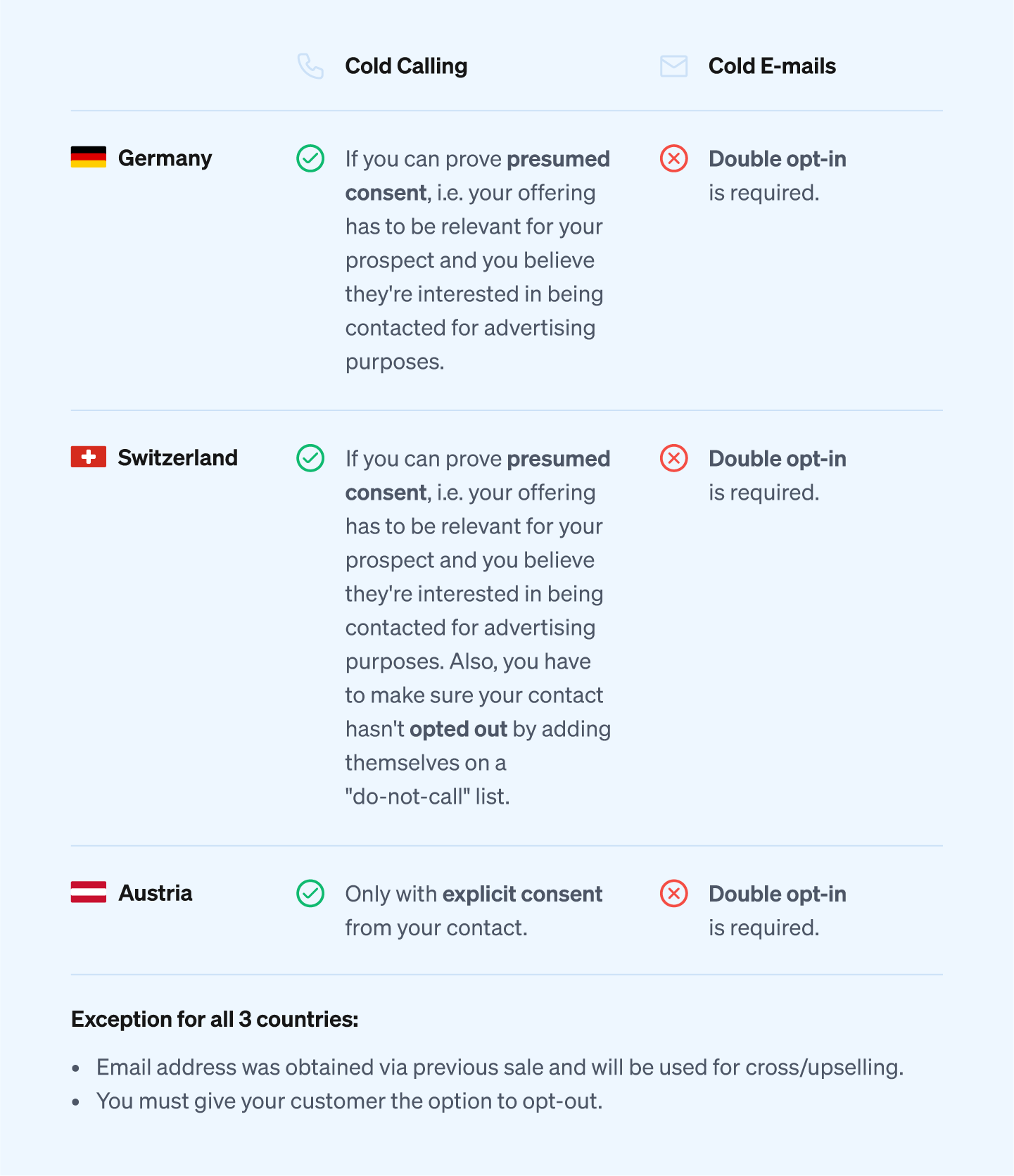
Social media platforms and business networks
Social selling can be a legal gray area in all DACH countries! Since business networks like LinkedIn are set up for business dealings, reaching out via direct message is often not objected to, but be sure your offering matches your prospect’s needs. Also, be sure to review, and comply with the terms and conditions of the social channel you are using for social selling. Some special rules may apply.
Trade shows and conferences
In all regions, reaching out to your target audiences at trade shows or conferences is a great way to generate leads compliantly. But, again, you're collecting first-person data here: data that goes from the customer directly to you.
Important:
Be sure to inform them on how you plan to use their collected data.
Always provide them with information on how to retract their permission if they want to.
Measuring and analyzing your B2B sales strategy
Looking at your strategy after it's rolled out is essential to your sales success. Why? Measuring and analyzing can tell you how effective your sales strategy is. Having data to compare can show you key areas that changed from month to month or quarter to quarter. You can take what you did right and repeat that or refine it to improve. Or you'll see what needs to be fixed and look for ways to change that part of the process.
Key metrics to track
Total revenue: This can be measured monthly, quarterly, or annually.
ARR (annual recurring revenue): This is the recurring revenue projected for a year.
ARPA (average revenue per account): The average revenue generated per account. This can be calculated on a monthly or yearly basis.
Average Sales Cycle: The amount of time from your first touch with a prospect to closing the deal.
Conversion rate: This is used to measure the effectiveness of a sales strategy or your team when it comes to converting leads into new customers
Main Activities: Used to measure your team's input based on discovery calls, demos, and negotiations. Measured on a weekly, monthly or quarterly basis.
Win rate: Your successfully closed deals.
Revenue of new vs. existing customers: A comparison of what your new vs. current accounts are bringing in.
Quota attainment: Displayed as a percentage and shows a salesperson’s total sales.
Sales forecasting
A sales forecast is a projection of expected sales revenue and answers the most important questions of “How much?” and “By when?”. The question of amount covers what you know about a potential customer and what they could bring to your business. The more robust and refined your sales process is, the more likely your forecast will be accurate.
Sales performance analysis
Understanding how your sales team is performing is vital. You want to know your current business health and compare it to where you want it to be. You can also gain insights into your salespeople by seeing if they’re achieving their targets or not. Where can you provide support to get them back on track?
Customer feedback
In an ideal world, your customers will only leave 5-star reviews and keep coming back for your product or service. The thing is, negative feedback is also extremely valuable to help your business grow.
Ask yourself the following questions first:
Why do you want their feedback? What are you trying to improve?
Do you have information for the customer about their privacy with data collection and processing?
Which channel or method will be most effective in feedback collection?
Some common methods of collecting customer feedback are surveys, customer testimonials, and asking for reviews on review platforms or via social media.
Your best practices checklist for B2B sales in the DACH market
As you’ve read, moving into the German-speaking market requires quite a bit of research, planning, and lots of resolve. But it’s absolutely worth it. Your potential customers in the DACH region are waiting for what you have to offer. Now, you just have to put it all together.
1. Build strong relationships
You're not after a short-term collaboration; you're trying to build a solid and loyal customer base. So don't give them a quick-fix solution and send them on their way. Instead, be the company they trust to do business with in the long-term, turn them into your biggest advocates!
2. Offer exceptional customer service
The German-speaking region expects knowledgeable customer service reps that resolve issues promptly. Remember, this region places a lot of value on reliability! The DACH region still prefers to contact customer service via email or telephone. And for the best customer experience, have a German-speaking customer service team.
3. Invest in local talent
Expanding upon the localized customer service team! The more your customer has localized/personalized touch points along their journey, the better. It is definitely worth it to have a local sales, account executive, and customer service team in place when moving into DACH. Going through the sales and onboarding processes and knowing someone speaks their language and understands them culturally will position you ahead of your competitors.
4. Stay compliant with local regulations
Set up a data compliance strategy including a team for data protection and outreach regulations so your organization can stay current on any changes in local regulations. Almost every department in your company will come into contact with compliance issues - be sure they have resources available to deal with them. The result of this preparation is that you can build trust with your customers. They'll know you're doing all you can to ensure their data is safe.
How Dealfront can help you to develop a winning B2B sales strategy for the DACH market
Dealfront is the go-to-market platform made in Europe, seamlessly integrates the tools and stages of the sales and marketing process into one cohesive platform. With five robust tools driving a powerful flywheel effect, it offers a comprehensive, GDPR-compliant solution, making it the optimal choice for businesses looking to streamline their go-to-market strategy.
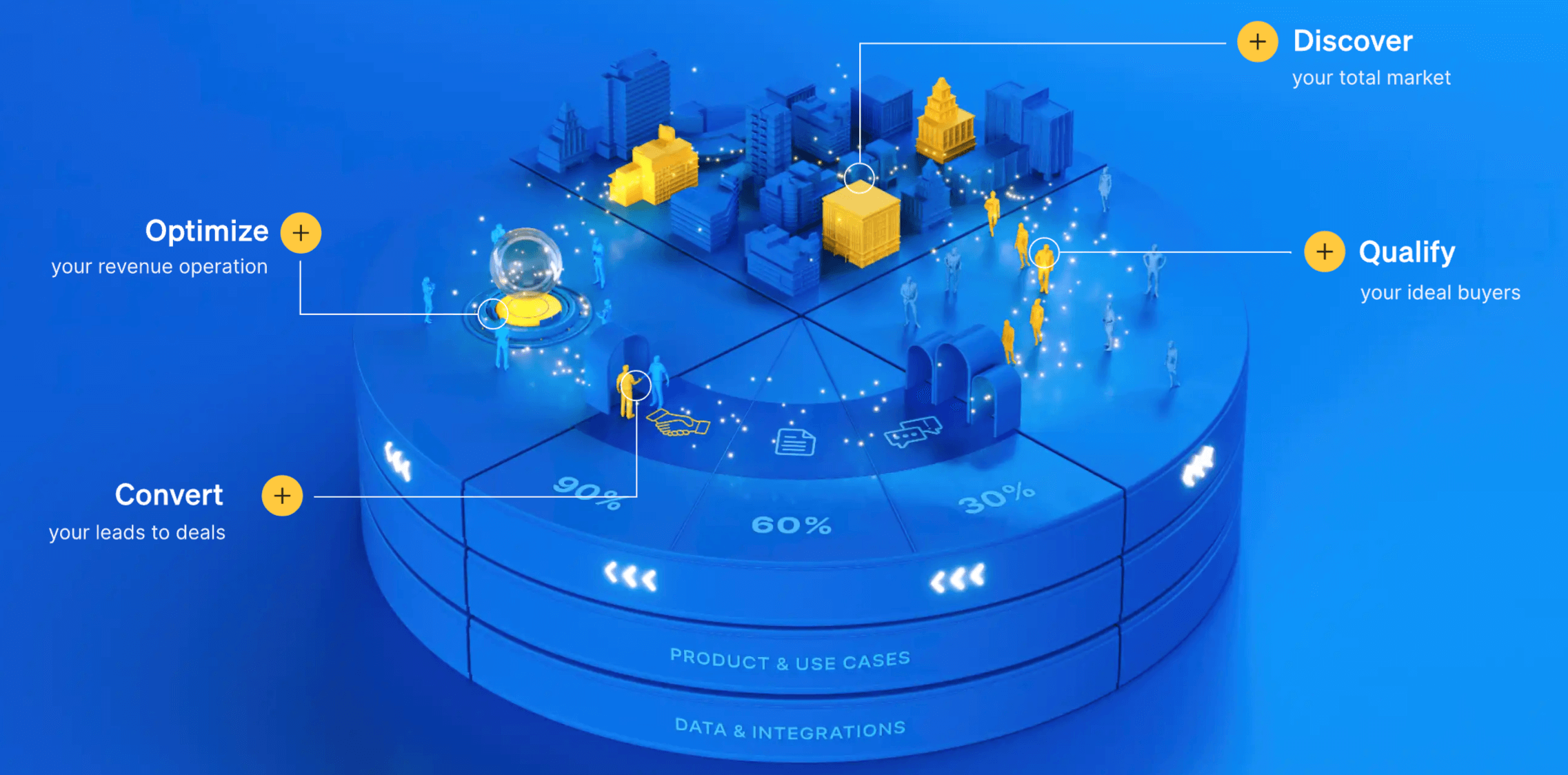
Discover: Unlock your total addressable market.
Qualify: Refine and prioritize your ideal customer profiles.
Convert: Reach the right buyers with the right message at the perfect time.
Optimize: Multiply your deals won using AI and machine learning algorithms to find B2B lookalikes.
The result is constantly refined accuracy, ICPs that are dynamic and real-time, and more leads that end in deals.
Now that you have the knowledge you need to break into the German-speaking market, all that’s left is for you to implement it!
